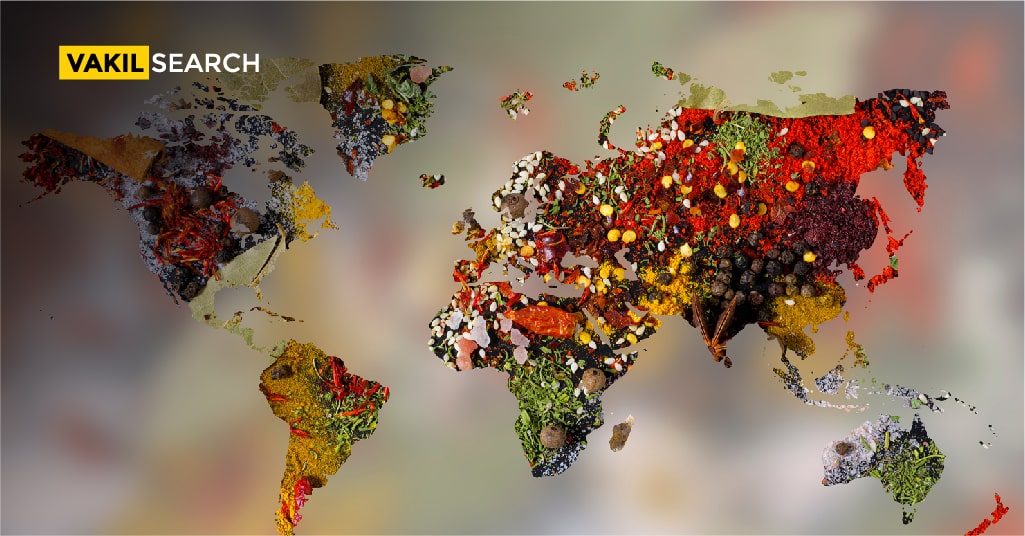The spice route, which originated in India thousands of years ago, is proof that spices were one of our earliest exports. Today India is one of the world's biggest spice manufacturers and exporters. We make it easy for you to get into the business.
Indian spices are valued for their high quality and flavour around the world. The climate in India, which has tropical and subtropical weather patterns, is ideal for growing almost all types of spices. A number of small landowners have converted to cultivating spices in the last ten years or so since they require less space and yield higher yields. As a result, India still produces more than 75 of the 109 different spices found worldwide and exports the majority of them. So, it is abundantly obvious that there is room for growth in India’s spice export industry. Continue reading to know about the benefits, types, documents required for Spice Export Business.
Benefits of Starting a Spice Export Business in India
- Indian spices are in remarkable demand and command high credibility within the international market
- The spice industry is a sustainable and economically viable option for raking in massive profits every year
- Further, spice exporters receive various subsidies that permit them to send samples of spices abroad at lower costs.
- Spice exporters also receive subsidies for creating promotional videos, brochures, and other marketing campaigns. Check Here to Know More about: http://www.indianspices.com/
Biggest Challenges Faced by the Spice Export Business in India
- There is a high credit risk for distributors and mediators within the spice industry, which has made new investors apprehensive
- Moreover, the absence of high-quality packers and labellers in the Indian spice industry has checked foreign buyers
- Likewise, the lack of access to high-tech machines has made expansion difficult for small-scale businesses
- Cutthroat competition in the spice market has made it difficult for new players to enter the spice market.
Different Types of Spice Export Businesses in India
The most common ways you can start a spice export business in India are as –
- Manufacturer of spices
- Merchant of spices
- Wholesale trader of spices
- 3rd-party manufacturer of spices
- A supplier/exporter of spices
Spices are produced on a big scale by producers, and merchants and traders serve as intermediaries to complete the logistical chain. To put it another way, spice producers act as the main producers, while merchants assist in ensuring that the spices get to the correct markets and end users. Additionally, third-party manufacturers assist with the manufacturing of spices in the nation, while suppliers assist with the export of the spices to other nations, and wholesale merchants make sure that retailers who package, distribute, and sell spices obtain the created spices.
Documents Required to Start a Spice Export Business in India
- Incorporation certificate
- Import export code
- Registration cum membership certificate from the spice board
- Goods and service tax
- MSME registration
- Trademark registration
- Food Safety and Standards Authority of India registration/license
- Passport size photo
- Phytosanitary certificate
- Authorized dealer code from a recognised bank
- Bank certificate and statement
- Company PAN card.
To obtain a certificate of registration as an exporter of spices or CRES, you will need the following:
- IEC certificate
- DD of INR 5,000 in favour of the spices board
- Confidential bank certificate
- GST registration certification
- PAN card.
You might also require a BIS certification under the ISI, wherein the specification for ground spices are as follows:
- Chili powder ISI number: 2445-1963
- Coriander powder ISI number: 2444-1963
- Curry powder ISI number: 1909-1961
- Turmeric powder ISI number: 2446-1963
- Sampling and testing of Spices ISI number: 1997-1961.
Steps to Start a Spice Export Business in India
- To begin with, entrepreneurs will need to determine the kind of business and the type of spices they want to specialise in. Additionally, you could opt to become a producer, wholesaler, supplier, retailer, or exporter, depending on your interest and the capital you have in hand
- Next, you will have to conduct market research to understand more about the spice market and the spices you intend to export. This will help you build a sustainable supply chain
- You would then have to meet with prospective suppliers and vendors. After deciding on a supplier, you can buy spices from them in bulk
- Further, to accommodate the spices bought in bulk, you will need a suitable storage location
- Hence, you will also need to install the right machinery and equipment to get the production facility running. The list of machinery required for starting a spice export business in India is as follows:
- Compressor
- Disintegrator
- Heat-sealing machine
- Packaging machine
- Roster
- Spice grinders and sieves
- Weighing scale
- Along the way, you will also need to find suitable investors and creditors to help finance your operations. If you are in need of a spice export business plan, Vakilsearch can help formulate the perfect one
- Similarly, it is also advisable to engage the services of legal experts such as Vakilsearch to understand the legal compliances and the different certifications required to start such a business
- Finally, you need to locate spice retailers in the countries you wish to export to. Once you establish a good working relationship with them you can begin exporting spices.
What Spices can be Exported from India?
India is a major exporter of spices and is known for its diverse range of aromatic and flavorful spices. Some of the key spices that are commonly exported from India include:
- Black Pepper: India is one of the largest producers and exporters of black pepper.
- Cardamom: Both green and black cardamom are exported from India.
- Turmeric: India is a significant exporter of turmeric, which is widely used as a spice and for its medicinal properties.
- Cumin Seeds: Cumin is a popular spice that adds a distinctive flavor to many Indian dishes.
- Coriander: Coriander seeds and powder are commonly exported, and coriander is a key ingredient in Indian cuisine.
- Red Chili: India is a major exporter of various types of red chili, including chili powder and whole chili.
- Fennel Seeds: Fennel seeds are exported for culinary and medicinal purposes.
- Mustard Seeds: Mustard seeds, both black and yellow varieties, are exported from India.
- Fenugreek: Fenugreek seeds and fenugreek leaves (kasuri methi) are commonly exported.
- Vanilla: India is a significant exporter of vanilla, which is used as a flavoring agent.
- Asafoetida (Hing): Asafoetida is used as a spice and a condiment, and it is exported from India.
- Nutmeg and Mace: These spices are exported, and India is known for its production of high-quality nutmeg and mace.
- Saffron: Saffron, one of the most expensive spices in the world, is also produced and exported from India.
- Tamarind: Tamarind is exported in various forms, including paste and pulp.
- Ajwain (Carom Seeds): Ajwain is used as a spice in many Indian dishes and is exported internationally.
- Curry Leaves: While not a spice, curry leaves are exported for their use in seasoning.
These are just a few examples, and India produces and exports a wide variety of other spices as well. The country’s rich biodiversity and climate conditions contribute to the cultivation of diverse and high-quality spices. Export regulations and restrictions may vary, so it’s important to check with relevant authorities for the latest information.
FAQs on Start a Spice Export Business in India
How can I start exporting spices from India?
Starting to export spices from India involves several steps:
Research and Planning: Understand the spice market, identify target countries, and research regulations and requirements.
Business Setup: Register your business and obtain necessary licenses and permits.
Quality Assurance: Ensure that your spices meet international quality standards. Implement good manufacturing practices (GMP) and Hazard Analysis and Critical Control Points (HACCP) if possible.
Connect with Suppliers: Establish relationships with reliable spice suppliers in India.
Export Documentation: Obtain an Importer-Exporter Code (IEC) from the Directorate General of Foreign Trade (DGFT) and other required export documents.
Packaging and Labeling: Ensure proper packaging and labeling compliance with international standards.
Shipping and Logistics: Choose reliable shipping partners and understand logistics involved in spice export.
Customs Clearance: Be aware of customs regulations and procedures in both India and the importing country. Market Research: Understand market trends, demand, and competition in the target countries.
Promotion and Marketing: Develop a marketing strategy to promote your spices internationally.
Is spice export profitable?
Spice export can be profitable, but success depends on various factors such as market demand, quality of the spices, competitive pricing, and effective marketing. Proper research, adherence to quality standards, and understanding the international market are crucial for profitability.
Which license is required to export spices from India?
To export spices from India, you need an Importer-Exporter Code (IEC) issued by the Directorate General of Foreign Trade (DGFT). Additionally, specific licenses or permits may be required for certain spices, and compliance with food safety and quality standards is essential.
Which spice is exported most from India?
Black pepper is one of the most exported spices from India. Other popular exports include cardamom, turmeric, cumin, and red chili.
What are the 7 Indian spices?
The term 7 Indian spices doesn't have a strict definition, but commonly referred to are the following spices that form the basis of many Indian dishes:
Cumin
Coriander
Mustard
Fenugreek
Turmeric
Cardamom
Asafoetida (Hing)
What are the top 10 most exported spices from India?
The top 10 most exported spices from India may vary, but generally, they include:
Black Pepper
Cardamom
Turmeric
Cumin
Coriander
Red Chili
Fennel Seeds
Mustard Seeds
Fenugreek
Vanilla









